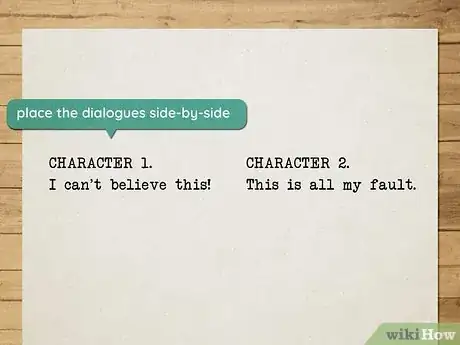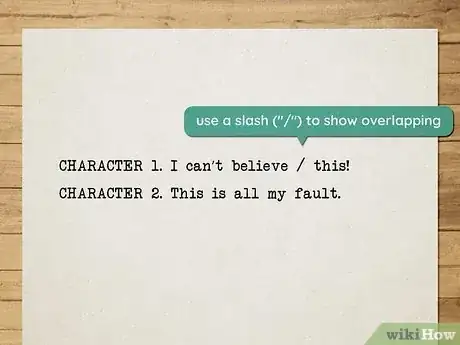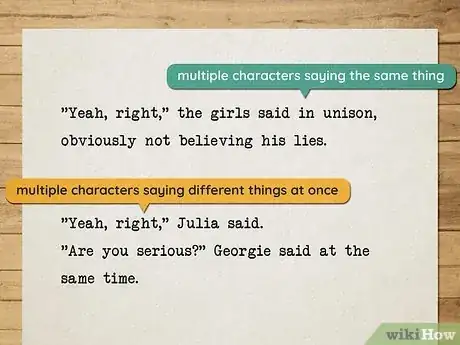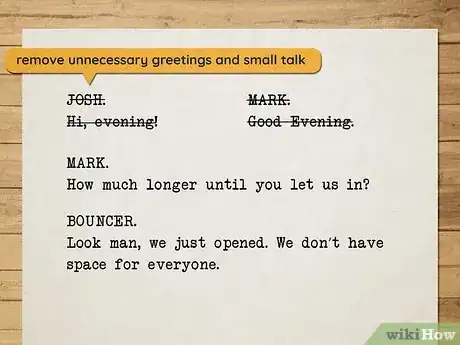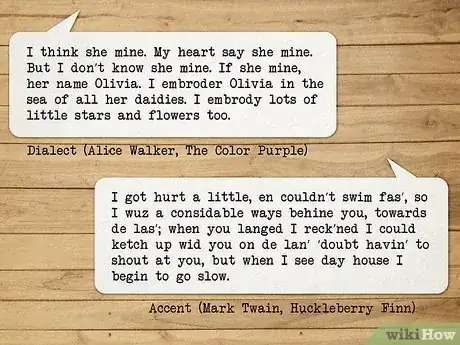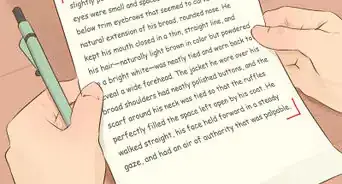This article was co-authored by wikiHow staff writer, Aly Rusciano. Aly Rusciano is a Creative Writer based outside of Nashville, Tennessee. She has over ten years of experience in creative, academic, and professional writing. Aly’s writing has been nationally recognized in the Sigma Tau Delta Rectangle and featured in Blue Marble Review, The Sunshine Review, PopMatters, and Cathartic Literary Magazine. She graduated from The University of Tennessee at Martin with a BA in English, focusing in Creative Writing and minoring in Theatre.
There are 8 references cited in this article, which can be found at the bottom of the page.
This article has been viewed 7,457 times.
Learn more...
Talking at the same time as someone else is a common occurrence when you’re in a group, but how do you write it on the page? Writing two characters talking at once can add conflict, emotion, and realism to your dialogue. In this article, we’ll teach you how to format overlapping dialogue, whether you’re writing a screenplay or novel, and share the best tips on writing awesome dialogue. So, pull out your project and picture your characters because we’ve got some dialogue to write.
Things You Should Know
- Format overlapping dialogue in scripts by placing dialogue side-by-side.
- Indicate which characters are speaking in prose using dialogue tags like “they said” or “said at the same time.”
- Give each character a unique voice, so their dialogue stands out on the page.
Steps
Tips for Writing Dialogue
-
1Remove greetings and small talk from your dialogue. When you’re writing dialogue, it’s important to remember your character(s)’s motivation—why are they saying what they’re saying? We use a lot of fluff when chatting in real life, but small talk about the weather or hellos may bore readers and draw them away from the page. Keep the civilities to a minimum and focus on the discussion's main subject (why, who, what, and how).[5]
- Now, there are always exceptions to this. Suppose you’re introducing a character to another character for the first time. In that case, greetings may be necessary but won’t be needed every time the character appears.
-
2Use different dialogue tags to add variety to scenes. “Said” is the universal dialogue tag; however, this doesn’t mean you have to use it every time a character speaks. Stick to using “said” 80 to 90% of the time, but also play around with different phrases, tags, and expressions.[6] Here are some different dialogue tags you can try:[7]
- Acknowledged
- Noted
- Stated
- Muttered
- Asked
- Gushed
- Exclaimed
- Groaned
- Agreed
- Grumbled
- Stuttered
-
3Make your character(s) voice stand out with dialects and/or vocabulary. Your characters are one of a kind, so don’t be afraid to give them speaking quirks and express their opinions. Give characters specific speech patterns or word choices. Not only does this help define a character’s personality, but it also helps define the character on the page. Think about when you talk with a group of friends—you all don’t use the same lingo or vocabulary, right? The same goes for your characters! [8]
- Dialect: “I think she mine. My heart say she mine. But I don’t know she mine. If she mine, her name Olivia. I embroder Olivia in the sea of all her daidies. I embrody lots of little stars and flowers too.” (Alice Walker, The Color Purple)
- Accent: “I got hurt a little, en couldn’t swim fas’, so I wuz a considable ways behine you, towards de las’; when you langed I reck’ned I could ketch up wid you on de lan’ ‘doubt havin’ to shout at you, but when I see day house I begin to go slow.” (Mark Twain, Huckleberry Finn)
- Expressing opinion: “”They’re certainly entitled to think that, and they’re entitled to full respect for their opinions,” said Atticus, ‘but before I can live with other folds I’ve got to live with myself. The one thing that doesn’t abide by majority rule is a person’s conscience.’” (Harper Lee, To Kill a Mockingbird)
-
4Determine the who, what, where, and why of a character’s situation. The speaking style of a character will change depending on what they’re doing and who they’re interacting with. For example, if a hot-headed character is angry, they’re not going to speak calmly if they’re insulted. Keep the character’s personality and surroundings in mind while writing dialogue to create authentic interactions.[9] Ask yourself these questions about your character:
- Who are they talking to or with?
- What are they doing physically? What are they thinking emotionally?
- Where are they located?
- Why are they in this scene?
-
5Read your dialogue out loud. Anything that doesn’t sound right won’t read right. This is especially important if you’re writing characters with accents or a specific dialect. Take some time to read your characters’ conversation aloud and ask yourself: (1) Does the conversation flow naturally? (2) Can I distinguish the voices of my characters? (3) Is something important revealed during the conversation?[10]
- Ask a friend or family member to read your dialogue out loud to hear it from someone else’s voice.
- Consider copying and pasting the dialogue into Google Translate or another speech program so the computer can read it back to you.
- If the conversation doesn’t sound right, go back and revise. Pretend you’re your character(s). What would you say in the given situation or in response to someone else? Sometimes even changing one word can make a huge difference!
References
- ↑ https://aitaf.org/best-practices-for-formatting-a-play/
- ↑ https://www.stagemilk.com/stage-directions/
- ↑ https://aitaf.org/best-practices-for-formatting-a-play/
- ↑ https://blog.reedsy.com/guide/how-to-write-dialogue/tags/
- ↑ https://blog.reedsy.com/guide/how-to-write-dialogue/
- ↑ https://youtu.be/aF-MdybhmyA?t=157
- ↑ https://blog.reedsy.com/guide/how-to-write-dialogue/other-words-for-said/
- ↑ https://writers.com/how-to-write-dialogue-in-a-story
- ↑ https://writers.com/how-to-write-dialogue-in-a-story
